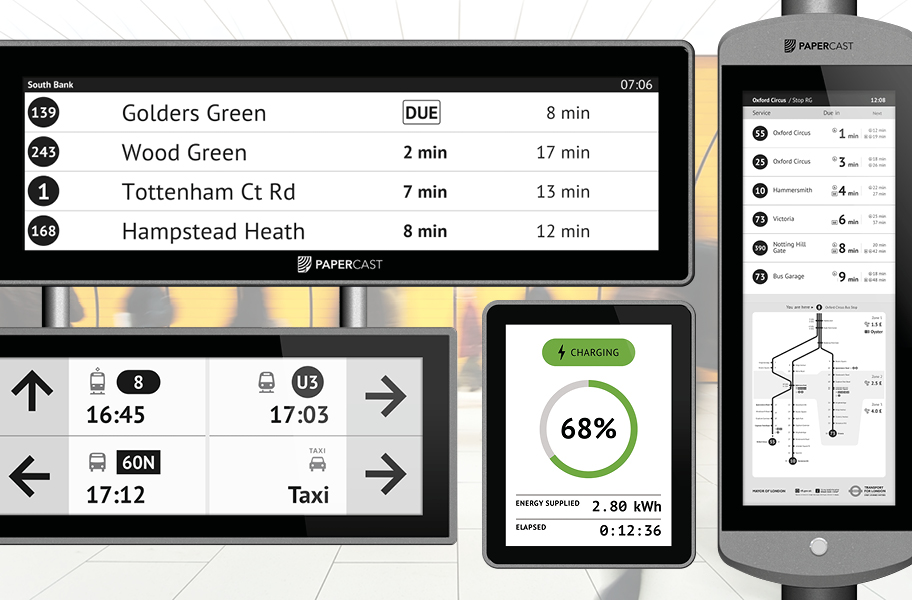Across the globe, Papercast ePaper Signage is emerging as a powerful solution for sustainable urban mobility. By reducing energy use, cutting carbon emissions, and eliminating the need for grid-based power, these solar-powered e-paper displays are helping cities modernize public transportation while staying eco-friendly. With climate goals pressing on every major urban center, Papercast’s approach to transit signage is proving to be both environmentally responsible and cost-efficient—setting a new benchmark for smart, sustainable infrastructure.
Why Papercast ePaper Signage is a Sustainable Choice
Ultra-Low Energy Consumption
At the core of Papercast ePaper Signage lies bistable display technology, which consumes energy only when information is updated. Once the data is shown, whether bus schedules, route alerts, or service changes, the screen holds it indefinitely without consuming any power. This, as Blog.EInk.com stated, is in stark contrast to LED or LCD boards, which demand continuous energy for backlighting and refresh cycles. By using significantly less power, Papercast displays directly contribute to lower operational energy footprints.
Solar Power and Off-Grid Operation
Another major advantage of Papercast ePaper Signage is its ability to run independently of the electrical grid. By pairing ultra-efficient displays with solar panels and battery storage, transit agencies can install signage virtually anywhere. That, as Papercast stated, includes even remote bus stops or locations where trenching for cabling would be costly and disruptive. This not only lowers infrastructure costs but also ensures reliable operation during power outages, creating a more resilient transit network.
Lower Carbon Footprint Across the Lifecycle
When scaled across a transit system, the environmental benefits of Papercast ePaper Signage are dramatic. E Ink’s analysis shows that 100,000 e-paper signs operating over five years could prevent hundreds of thousands of tons of CO₂ emissions compared to LED alternatives. Beyond energy savings, the durability and longevity of Papercast’s hardware reduce waste from frequent replacements, while also eliminating the recurring emissions of printed signage production and distribution.
Benefits for Transit Agencies and Riders
Better Rider Experience with Real-Time Information
For passengers, Papercast ePaper Signage means reliable, real-time information that is visible in all conditions—bright sun, dusk, or night. Because the displays are reflective rather than emissive, they produce less glare, while integrated low-power lighting ensures readability after dark. Riders benefit from consistent access to arrival times, route changes, and service alerts, even during grid outages.
Cost Efficiency for Transit Authorities
From an operational perspective, Papercast ePaper Signage helps agencies save money. The technology reduces the need for constant electricity, minimizes wiring costs, and lowers the frequency of on-site maintenance. Over time, these savings offset the higher initial investment in solar-equipped units, making them an attractive option for agencies managing large-scale networks.
Challenges to Consider
While the environmental and economic case for Papercast ePaper Signage is strong, agencies should weigh certain considerations:
- Update Frequency: In regions with limited sunlight, frequent updates may strain solar and battery reserves.
- Upfront Costs: Initial deployment requires more investment than traditional printed or non-digital signage.
- Weather Dependence: Harsh climates, heavy snow, or prolonged storms may affect solar performance. However, Papercast’s ruggedized designs mitigate these risks.
- System Integration: Large transit networks need to ensure consistency and compatibility across thousands of installed units.
Why Papercast ePaper Signage is Trending Now
Global climate policies, urban sustainability goals, and rising energy costs are driving momentum toward greener technologies. Papercast ePaper Signage aligns perfectly with these priorities:
- Supports Climate Goals: Helps cities reduce emissions and meet sustainability targets.
- Complies with Regulations: Meets energy efficiency and light pollution standards better than LED signage.
- Technological Readiness: Advances in solar power, batteries, and e-paper displays make deployment more reliable and scalable.
- Visible Commitment to Sustainability: Because signage is so public-facing, adopting Papercast solutions sends a clear message of eco-conscious innovation to communities.
Conclusion
Papercast ePaper Signage represents a breakthrough at the intersection of green technology and urban mobility. With its solar-powered operation, low energy consumption, and durable design, it enables transit authorities to provide real-time information while dramatically reducing environmental impact.
For cities under pressure to reduce carbon emissions, enhance rider experience, and cut infrastructure costs, Papercast’s technology offers not just an incremental upgrade but a transformational solution. As urban planners and transit agencies worldwide rethink their strategies for sustainable growth, Papercast ePaper Signage is set to become the gold standard for eco-friendly public transit communication.


